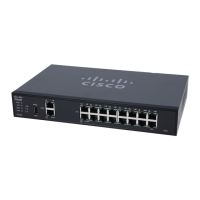Step 4
Select the Downstream Interface, WAN or VLAN1.
Step 5
Click Apply.
RIP
Routing Information Protocol (RIP) is the standard IGP that is used on Local Area Networks (LAN). RIP
ensure a higher degree of network stability by quickly rerouting network packets if one of the network
connections goes off-line. When RIP is active, users experience little to no service interruptions due to single
router, switch, or server outages if there are sufficient network resources available.
To configure RIP, follow these steps:
Step 1
Select Routing > RIP.
Step 2
To enable RIP, check IPv4 or IPv6 or both and configure the following:
Check Enable in the corresponding Interface to allow routes from upstream to be
received.
Checking Enable for an interface automatically checks RIP version 1, RIP
version 2, RIPng (IPv6), and Authentication for that interface. Similarly,
unchecking Enable unchecks all.
Note
Interface
This protocol uses classful routing and does not include subnet information or
authentication.
•
Check Enable to enable sending and receiving routing information on RIP
version 1.
•
Check Passive to disable routing information from being sent on RIP version
1.
Passive configuration is activated only when Enable is
checked.
Note
RIP version 1
This is a classless protocol that uses multicast and has a password authentication.
•
Check Enable to enable sending and receiving routing information on RIP
version 2.
•
Check Passive to disable routing information from being sent on RIP version
2.
Passive configuration is activated only when Enable is
checked.
Note
RIP version 2
RV345/345P Administration Guide
64
Routing
RIP

